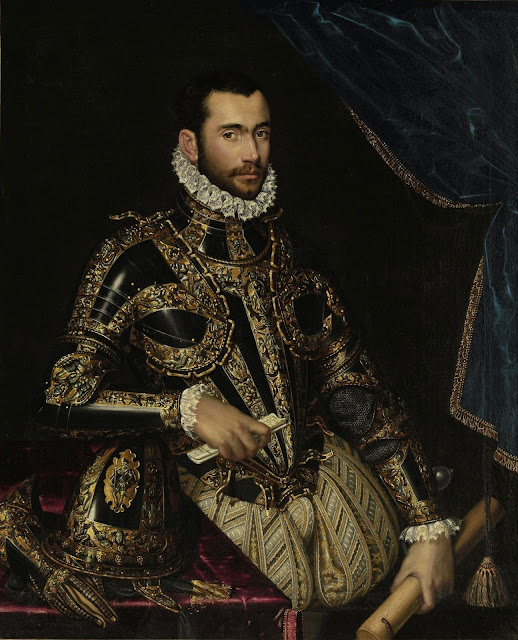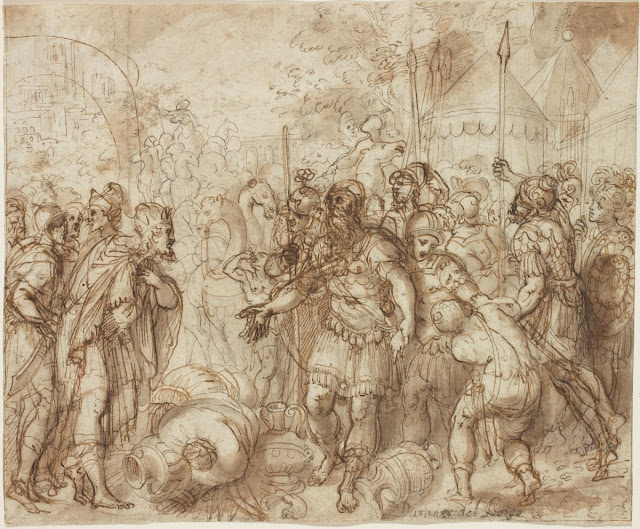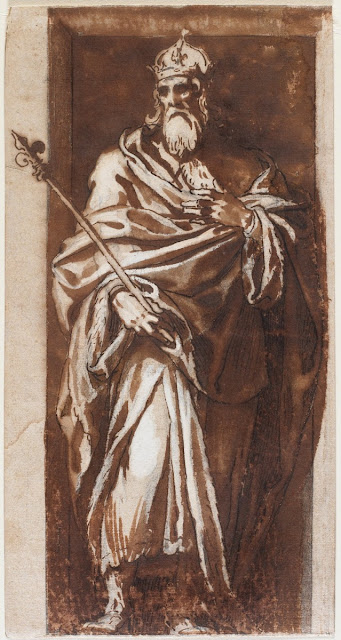 |
| Scipione Pulzone Portrait of Jacopo Boncompagni 1574 oil on canvas private collection, Washington DC |
"Jacopo Boncompagni was the natural son of the Bolognese cleric Ugo Boncompagni, later Pope Gregory XIII and Maddalena da Carpi. Legitimized early on, Jacopo moved to Rome when his father was elected to the papacy in 1572. He was nominated castellan of Castel Sant'Angelo and shortly thereafter commander general of the papal troops. . . . In 1576 the Pope arranged for his son an appropriate marriage with Costanza Sforza di Santa Fiora, and in 1577, 1579 and 1583, respectively assured him the fiefdoms of Vignola, Sora and Aquino. Just a few years after the Council of Trent and the severe, reform-minded pontificates of Pius IV and Pius V, Jacopo Boncompagni's career marked the most definite return of papal nepotism."
 |
| follower of Girolamo Muziano Landscape with St Onophrius after 1574 oil on copper National Gallery of Canada |
"In the first half of the 1570s, Girolamo Muziano produced a series of remarkable drawings depicting Penitent Saints in landscapes. These were far from being his first essays in landscape art: when he arrived in Rome around 1550 he was known as il giovane de' paesi, "the youth of the landscapes." Yet Muziano's drawings of Penitent Saints, six of which were engraved by Cornelis Cort [including one directly below] marked a significant new development in the rise of landscape art in Italy. Landscapes all'antica had long been a mainstay of villa decoration – Muziano himself painted them at the Villa d'Este in Tivoli – but Polidoro da Caravaggio's Fetti chapel in San Silvestro al Quirinale, painted in the 1520s, was the only notable earlier Roman example of what might be called "sacred landscapes," with small-size religious figures set in a broad panorama. Muziano's Penitent Saints had a great and lasting impact on Roman art. They lie behind the subsequent rapid proliferation of landscape painting in the projects carried out, often under Muziano's supervision, during the papacy of Gregory XIII, of which the Gallery of Maps and rooms in the Tower of the Winds in the Vatican are the most notable."
 |
| Cornelis Cort after Girolamo Muziano St Onophrius 1574 engraving Rijksmuseum, Amsterdam |
 |
| Raffaellino da Reggio The Apparition of the Angel to St Joseph ca. 1575 drawing Morgan Library, New York |
"Raffaellino is said to have arrived in Rome during the pontificate of Gregory XIII, or possibly somewhat earlier, and spent the rest of his brief career there. This magnificent drawing is a late compositional study for the fresco The Apparition of the Angel to Saint Joseph painted around 1575 on the vault of the Orsini (later Ghislieri) Chapel in the Church of San Silvestro al Quirinale in Rome, still extant. By the time he received the San Silvestro commission, Raffaellino had worked as Giovanni de' Vecchi's assistant on the frescoes in the Villa Farnese at Caprarola (ca. 1574) and was working independently on the Loggia of Pope Gregory XIII in the Vatican (1575-1577), the Oratorio del Gonfalone, and his only known oil painting, the Tobias and the Angel in the Galleria Borghese [directly below]. Both Raffaellino's paintings and drawings reveal him to be a close follower of Taddeo Zuccaro, who had died before Raffaellino settled in Rome. Inspired by both Taddeo and his brother Federico's calligraphic handling, Raffaellino developed a virtuoso style characterized by an elegant pen line, generous dark brown washes that modulate the design, dynamic compositions and elongated facial types."
 |
| Raffaellino da Reggio Tobias and the Angel ca. 1575-78 oil on panel Galleria Borghese, Rome |
 |
| Durante Alberti Scene from Roman history ca. 1575 drawing National Gallery of Canada |
"Durante Alberti was from a different branch of the Sansepolcro family than his better-known cousins Cherubino and Giovanni Alberti. Like many members of this distinguished family of artists, Durante moved to Rome as a youth to seek his fortunes – by the early 1560s in his case. He would distinguish himself primarily as a painter of altarpieces for several prominent churches in Rome, although the present drawing provides unique evidence of his secular work. . . . The subject of this work remains to be identified, though the intent seems clear as a captured King is brought before a military commander to plead for clemency. For its frieze-like design with a dramatically posed central figure, the image betrays the influence of the frescoes executed by Polidoro da Caravaggio in the 1520s on so many palace facades in Rome, most often with violent scenes of Roman history. Durante was clearly a conscientious student of post-Raphael Rome. For example, the bending figure of the child on the right hand side is a direct quotation from Pellegrino Tibaldi's fresco featuring a fictive doorway opened to reveal two servants in the Sala Paolina in the Castel Sant'Angelo, Rome. The purpose of the drawing is not entirely evident, however it is reasonable to assume it was for an external facade fresco on a Roman palace."
 |
| attributed to Cesare Nebbia The Emperor Charlemagne ca. 1572-82 drawing National Gallery of Canada |
"Although the drawing has long been attributed to Girolamo Muziano, its technique, featuring a broad use of fluid brown wash and white heightening, is not one typically found among the artist's works. The sheet might usefully be compared, however, to drawings by Muziano's primary pupil and assistant, Cesare Nebbia. . . . Although not by Muziano himself, the drawing nonetheless seems to relate to a project for which Muziano was responsible. Sometime in the 1570s, Muziano was commissioned to paint an Assumption of the Virgin, along with flanking images of Charlemagne and Saint Louis, for the choir of San Luigi dei Francesi, Rome. . . . As with other projects from the 1570s, the work was probably a collaborative endeavour of the two artists. . . . Muziano, throughout his career, seems to have avoided working in fresco whenever possible, favouring instead the technique of oil on canvas, but Nebbia was a proficient fresco painter, and Muziano on more than one occasion handed over fresco projects to the younger artist. . . . It is likely that when commissioned to paint both the high altarpiece (on canvas) and flanking frescoes at San Luigi, a similar division of work ensued."
 |
| Federico Zuccaro Design for Quarant' Ore Decoration (Forty Hours Devotion) ca. 1580 drawing Metropolitan Museum of Art, New York |
"Gere first identified the highly finished sheet as design for a Forty Hours' Devotion, likely dating, as the heraldic Boncompagni dragons indicate, from the pontificate of Gregory XIII. For a period of forty hours the consecrated host was presented for the adoration of the faithful, displayed within a highly elaborate ephemeral architecture erected in front of the altar and dramatically illuminated by hundreds or even thousands of candles and oil lamps. Increasingly popular from the late sixteenth century, the liturgical devotion reflected both the centrality of the Eucharist for the Counter-Reformation church and the theatricality of its cult. These ephemeral staged settings increased steadily in grandeur and size and presented ever more elaborate iconographic programs. They offered important opportunities for innovative design and would decisively inform the later developments of permanent church and altar solutions. . . . [Zuccaro's] Forty Hours Devotion was probably intended for the Pauline Chapel in the Vatican and executed when Gregory XIII commissioned him in 1580-1584 to complete the fresco decoration of the chapel that Michelangelo had begun almost four decades earlier under Paul III."
 |
| Federico Zuccaro Porta Virtutis or Gate of Virtue 1581-82 drawing Morgan Library, New York |
"The drawing is one of three studies related to the "Porta Virtutis" scandal that caused Federico Zuccaro to be expelled from Rome in November 1581 on the orders of Pope Gregory XIII Boncompagni. The artist had painted a wall hanging, often referred to as a large cartoon, depicting a Minerva beneath a triumphal arch guarding the realm of artistic virtue from Crass Ignorance and Envy. The cartoon had been prominently displayed on the facade of the church of San Luca in Rome on 18 October 1581, the feast day of Saint Luke, when painters traditionally gathered for a religious celebration. The image was interpreted – and probably originally intended – as a satire on the ignorance of Federico's former patron Paolo Ghiselli (who had rejected the artist's altarpiece commissioned for his chapel in Bologna), and the circle of Bolognese artists who had advised Ghiselli. In the wake of the Council of Trent and the precepts on art that it promulgated, the Bolognese altarpiece, which featured large nudes in the foreground, was probably considered unseemly. . . . The Porta Virtutis or Minerva Triumphant cartoon was executed primarily by Federico's pupil Domenico Passignano and both artists thereupon stood trial for having slandered the Bolognese painters and Ghiselli. On 27 November 1581 Pope Gregory XIII personally intervened to have the pair banished permanently from Rome. This incident signified a complete reversal of fortune for Federico, who had previously been employed by the Pope on the decoration of the Pauline Chapel in the Vatican. . . . Even though Federico was granted a pardon less than two years later through the vigorous intervention of the Duke of Urbino, he had to leave Rome within four days of the proclamation of the ban."
 |
| Girolamo Muziano Seated draped male figure gesturing to the right ca. 1582 drawing Morgan Library, New York |
"This impressive figure study is characteristic of Muziano's finest draftsmanship of the early 1580s, when the artist was almost exclusively employed by Pope Gregory XIII. Inspired by the highly finished late chalk drawings of Michelangelo, Muziano, like Daniele da Volterra and others of his generation, precisely outlined the draperies, capturing the underlying musculature, and, with fine hatching, created rich tonal effects that impart a sense of weight and volume to his figures. The barefoot, bearded man in the present drawing is shown seated on an earthen mound or rocky ledge, fixing his gaze and attention on something beyond the paper's edge. He holds a handkerchief-like piece of cloth in his raised right hand. The purpose of the drawing remains unknown. The figure resembles a saint or prophet, who, however – with the possible exception of the small piece of cloth – lacks attributes."
 |
| Jacopo Zucchi Allegory of Creation ca. 1585 oil on copper Galleria Borghese, Rome |
"The early attributions of this painting reflect the extent to which it embodied artistic trends in Rome towards the end of the Cinquecento, from Arpino's highly wrought cabinet paintings to Brueghel's small landscapes, with still-life elements executed in miniaturist detail. The painting, however, also demonstrates the lessons Zucchi learnt in his native Florence where, under Vasari, he collaborated in the production of small-scale paintings for Francesco de' Medici. . . . Contemporary documentation of this painting has yet to emerge, but comparisons with Zucchi's Roman works strongly suggest it was executed around 1585. The most likely patron was Cardinal Ferdinando de' Medici, Francesco's brother."
 |
| Jacopo Zucchi Design for an Altar ca. 1587-88 drawing National Gallery of Canada |
"Born in Florence, Zucchi settled in Rome in 1572, after already having worked there as Vasari's assistant at the Vatican, executing decorations for Pope Pius V. Zucchi became court artist to Cardinal Ferdinando de' Medici in Rome during the 1570s, and at the end of the 1580s he painted major frescoes in the Palazzo Ruspoli for the Rucellai, another aristocratic Florentine family. . . . The sheet [directly above] is a fully resolved design for a substantial frame, including the predella, altar table, and surrounding elements featuring two angels holding palms of martyrdom. . . . Whatever its original purpose, the quality and ambition of the drawing are not in question. It is a major example of a design for a frame, generally inspired by Michelangelo's architecture, for a Roman altarpiece from the second half of the sixteenth century."
 |
| Cesare Nebbia Saint Jerome with two Putti ca. 1588 drawing Morgan Library, New York |
"With intermittent visits to his native Orvieto, Nebbia resided in Rome from the late 1570s, occupied in private and papal commissions. When Felice Peretti, who was once aptly described as possessing a feverish "almost pathological" drive to rebuild the face of Rome, ascended the papal throne in 1585 as Sixtus V, he appointed Nebbia and the Modenese artist Giovanni Guerra as superintendents of his decorative projects. Together, Nebbia and Guerra commanded a large team of artists who decorated the vast interiors of the newly erected buildings and renovated structures with expansive fresco cycles and occasional stucco framing elements. . . . The abundance of designs by Nebbia for Sistine projects suggests that from 1585 to 1590 the artist was working almost exclusively in the service of the pope. . . . The present drawing is a preparatory study for a spandrel fresco of the Benediction Loggia adjoining the church of San Giovanni in Laterano, decorated ca. 1587 at the behest of Sixtus V."
 |
| Giovanni Baglione Study for the Babylonian Library ca. 1588-89 drawing Teylers Museum, Haarlem |
"This drawing is a preparatory study for the left part of the Babylonian Library, the second of eight frescoes devoted to the great libraries of antiquity in the Sistine Salon of the Vatican Library. More specifically – as the caption below the painting indicates – it represents Daniel and his companions studying the language and learning of the Chaldeans. The extensive decoration, commissioned by Sixtus V for the new site of the pontifical library, was carried out between 1588 and 1589 under the supervision of Giovanni Guerra and Cesare Nebbia, the two artist-entrepreneurs who directed the majority of the Peretti pope's pictorial projects. Guerra designed the ornamental arrangement, provided drawings for the allegorical figures, and assigned the painters their individual tasks; Nebbia mainly made the drawings for the historical and narrative scenes and followed their execution in buon fresco. . . . The fresco representing the Library of Babylon is generally attributed to Giovanni Baglione, a capable and prolific painter often remembered only as a biographer of artists and the rival of Caravaggio."
 |
| Pasquale Cati Death of the Virgin ca. 1588-90 drawing National Gallery of Canada |
"Born in Jesi in the Marche region of Italy, Pasquale Cati is first recorded in Rome in 1577, during the pontificate of Gregory XIII. He seems to have spent his entire career in Rome, and although little known today, he had the confidence of a succession of popes for whom he worked on major decorative projects. . . . Formerly given to Girolamo Muziano, this hitherto unpublished drawing was first attributed to Pasquale Cati by Cristiana Romalli, who also connected it to the artist's most important work, the fresco in the chapel built by Cardinal Marco Sittico Altemps in Santa Maria in Trastevere in Rome. . . . This compositional drawing is preparatory for the upper section of the space featuring the Death of the Virgin, a subject related only in apocryphal sources."
– quoted passages from a 2009 exhibition catalogue issued by the National Gallery of Canada – From Raphael to Carracci: The Art of Papal Rome, edited by David Franklin